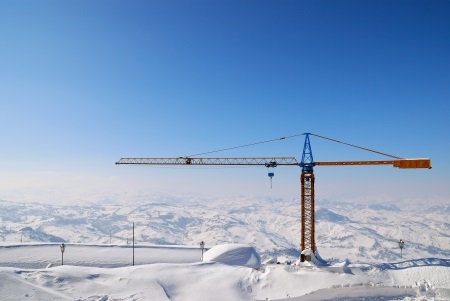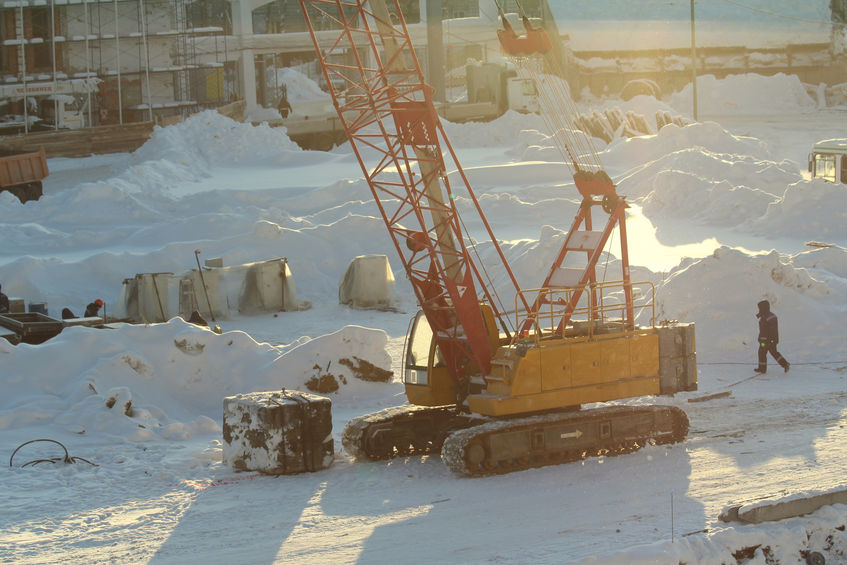
Astro Crane serves New England, and Boston, Massachusetts, is one of the major cities in the region. Did you know the temperature in Boston on most January days is between 23 and 36 degrees? And that the city and region experiences essentially constant cloud cover? The average hourly wind speed in Boston in January is around 8.8 miles per hour. So it’s cold, cloudy and windy– welcome to a New England winter season, right?
Winter Elements and Construction Cranes
How does winter weather affect construction cranes? Well, most cranes are made of steel, and when the temperature plummets below freezing, steel can become dangerously brittle. Obviously, crane operators want to maintain efficiency, safety and dependability, but that can be a challenge during a New England winter.
Preparing Cranes and Equipment for Winter
Crane equipment must be “winter-ready” in New England. This means machinery should be insulated, utilizing severe-duty motors complete with sealed bearings and motor strip heaters. It’s a good idea to inspect all components to make sure they’re up to the necessary ratings. Everything from brakes to electrical enclosures should be checked.
Are the grades of the oils and fluids correctly selected for winter temperatures? Do components needing sealing and corrosion resistance have the reinforcement they need to handle a cold, icy winter? Does hoist equipment meet the standards of the American Society of Mechanical Engineers (applicable to cold-weather operations)? And, finally, when doing job prep, is there auxiliary power available? It also helps to have insulated covers as well as heaters for tanks.
If winds should reach dangerous speeds, the crew will need to shut down operations. While this is true in any season, it’s especially important in winter when there’s blinding snow involved!
Freezing Cold Temperature Complications

Freezing cold temperatures tend to weaken hydraulic crane systems such that operators may need to derate a crane’s hydraulics and load capacity. Ideally, it’s best to protect a crane from any accumulating snow and ice, which could definitely add too much weight to the overall structure and make it unsafe. If possible, use an enclosed track system which protects against snow and/or ice. Many cranes can be outfitted with a cold weather package.
It’s important to know a machinery’s limits and apply precaution when operating a crane in winter weather. It’s always better to be on the safe side rather than trying to “overdo” something.
Winter Weather Checklist for Construction Cranes
Winter weather can include things like sleet, snow and ice, all of which complicate a job. Therefore, it’s crucial that crew members and crane operators are communicating clearly at all times. It’s very easy for visibility to become compromised when blustery snow sneaks up on a crew trying to complete a project.
Removing accumulations of snow and ice on crane equipment is important because you don’t want to add weight to a lift and end up dealing with capacity issues. Also, accumulated snow and ice, coupled with winter winds, can make it harder to place objects as desired. Typically, before a lift begins, any issues related to snow/ice/wind need to be considered and, better yet, resolved.
Not only is wind a problem for crane operators, but gusts that get to 20 miles per hour or more typically cause a crane’s lifting capacity to be derated. Cranes should ideally have wind speed gauges that can be monitored for safety’s sake.
Hazards to Avoid
When cranes are working in winter weather conditions, there are several hazards. Think about equipment risks and vehicular risks. You don’t want cranes and/or hoists to swing awkwardly, allowing construction materials to break loose when they shouldn’t be loose. What’s more, getting a crane to/from a site in winter weather, over roads, often involves freezing rain, ice pellets and fog, making travel treacherous. Drivers have to watch out for utility lines and poles, and anything that isn’t “where it should be.” Winter weather can be unpredictable, and that’s not helpful when a crew wants everything stable and predictable.
What about the human element of crane operation when it’s cold outside? There’s the risk of hypothermia! When people work outdoors too long in windy, cold environments, without any breaks, they can develop hypothermia and/or frostbite. It’s important to wear proper clothing and footwear for winter conditions. And it’s also important to take breaks somewhere “inside” to warm up after a while in the freezing cold weather.
Time Blocks
If possible, use a crane during daylight hours and on the warmer days of winter. When it’s dark and cold outside, crews aren’t usually as productive as when it’s partly sunny and warmer out. The less time equipment has to run in the winter, the better, because that helps prolong its service life– even if it’s winterized.
Pre Startup
Before starting work, crane operators should warm up their crane a bit. For cranes with hydraulic steering, some warm-up time will help with better steering response. And if there are days when the crane won’t be needed, it’s still a good idea to run it for a while rather than let it sit out in the cold for long periods of time never being turned on.
Just like with car batteries, it’s a good idea to pay attention to battery life. You may have some weather corrosion that needs attention and/or you may need to change out a battery from time to time in the winter.
Watch For Ice
Check cranes for ice. Look for muddy areas. Wherever you see mud caked on the machine, keep in mind that ice can get trapped around there, causing moving parts to stick. Meanwhile, ice can cause your machinery to crack and rust. It’s a good idea to look over machinery before using it (and while using it)– checking things like the brakes, throttle and exhaust.
Winter weather can make life challenging– that’s for sure. Moreover, it can also make crane operation more involved. Astro Crane can answer your questions and help you find the right crane for your winter crane project in New England– just call us at 978-429-8666.

